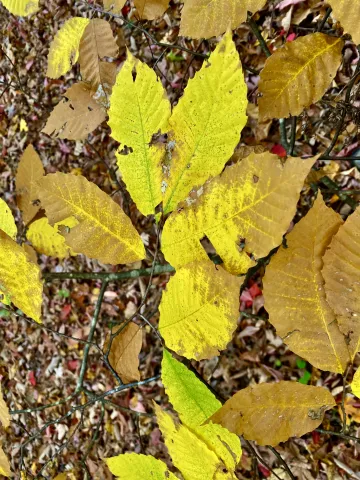After the fall: Some leaf science

after leaves turn brown in the Fall they still have an
important job to do.
By Steve Roark
Volunteer Interpreter, Cumberland Gap National Historical Park
Tree leaves are most appreciated when they go through their fall color blitz that we enjoy every year. But they should also be appreciated for all they do throughout the year, including creating food and fiber through the miracle of photosynthesis, and through their death their provision of a raw materials needed for next year’s growth of new leaves. Going from dead leaves to nutrients that can be taken up by a tree requires an amazing recycling system.
Plants need certain chemicals to grow and produce food that sustains the entire forest ecological system. Calcium, nitrogen, phosphorous, and many other elements are taken up from soil by plant roots. These elements enter the soil through the recycling of dead vegetation, animal carcasses, and animal wastes that accumulate on the ground as organic litter. A complex community of bacteria, fungi, protozoans, and many other kinds of micro-beasties live in the soil and carry out the vital task of decomposition that ultimately leads to what is called biogeochemical cycling. This is where organic material is finally broken down into individual atoms that can move from the soil and be taken up by plant roots.
The carpet of dried leaves, twigs and other debris that covers the forest floor is called the litter layer, and here is where recycling begins. If you dig into it, you will note that the upper layer is made up of leaves that are more or less intact. Newly fallen leaves contain a great deal of potential food energy that is tapped by the many inhabitants in the soil.
As you dig deeper in the litter layer, the leaves will become increasingly moist and flimsier. Deeper still the leaves become increasingly skeletonized, where all the softer tissue has been broken down, leaving only the tougher veins and stem. Decomposing leaves become darker in color and feel slimy due to a coating of microorganisms.
If you look closer you may notice thin, white threads growing on the leaf surfaces, produced by the many fungi that consume dead material. On down the leaves become broken up and unrecognizable. The litter here is dark, gritty, and moist. This is the humus layer and is where organic matter from formerly living things finally becomes the simple chemicals that can be taken up by plants to make them grow.
I do not mean to sound overly profound, but in the forest, death is as important as life. And while decaying things may smell bad and are often shunned by us humans, without this important recycling process, life as we know it could not exist.
- Log in to post comments